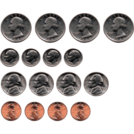
Exploring Equality - Mathematics Instructional Plan
- Subject:
- Mathematics
- Material Type:
- Lesson Plan
- Provider:
- VDOE
- Author:
- VDOE
- Date Added:
- 10/07/2024

Exploring Equality - Mathematics Instructional Plan

Representing multiplication facts; Creating and solving multiplication problems - Mathematics Instructional Plan

Exploring Equal Shares Through Division and Multiplication Strategies - Rich Mathematical Task Template and Student Version

Multiplying with 0, 1, 2, 5, and 10 - Mathematics Instructional Plan

This is a cross-curricular activity that uses the story Alexander, Who Used to Be Rich Last Sunday to practice money and decimal skills in addition to reading and writing skills. After reading or hearing the story, students will complete the attached worksheet. (If it's read aloud, students would need a way to refer back to the story to answer the questions. The worksheet has a mixture of reading and math questions. It can be edited if you choose. It can be used for either 3rd or 4th grade. With slight modifications, it could also be used for middle school EL students to learn about currency.

Exploring equality -- Mathematics Instructional Plans (MIPs) help teachers align instruction with the 2016 Mathematics Standards of Learning (SOL) by providing examples of how the knowledge, skills and processes found in the SOL and curriculum framework can be presented to students in the classroom.

With this lesson, students will practice the Math Standards of Learning around counting and comparing values of money and creating equations while also learning computer science terminology for problem solving. Students will learn to start counting change with the highest value coin possible.

This resource is a remix from Illustrative Mathematics.This encourages student collaboration and allows students to have a mathematical dialogue to express their understanding of algebraic properties. This resource is a valuable part of building background when introducing units of measure or equations in the early elementary years of mathematics education as it provides students a concrete example of building an equation with concrete objects. Suggested Modification- Encourage student online portfolio - A student recording sheet with dominos illustrations can be used as a reference for students to have a mathematical dialogue. Teachers can use online educational platforms that would allow students to record their own understanding of math and share them with the teacher. For example, Seasaw is an educational platform that students can use, but will require parental permission. It allows collaboration between teachers, students, and the parent community where students can have a voice and choice in their learning.

I created the Equations True or False Jamboard to give my students practice with identifying equations. They used a graphic organizer to solve each equation and then sorted it to the true or false column. You could also have students work the problems on whiteboards. Before doing the sort, we practiced finding the answers to equations and creating equations that were true. We talked about the equal and not equal sign and how that might change whether or not an equation is true or false. This activity supports sol 3.17.

Standard of Learning (SOL) 3.4a
The student will represent multiplication and division through 10 x 10, using a variety of approaches and models.

Standard of Learning (SOL) 3.4b
The student will create and solve single-step practical problems that involve multiplication and division through 10 × 10.

Standard of Learning (SOL) 3.4c
The student will demonstrate fluency with multiplication facts of 0, 1, 2, 5, and 10.

Standard of Learning (SOL) 3.17
The student will create equations to represent equivalent mathematical relationships.

Standard of Learning (SOL) 3.4d
The student will solve single-step practical problems involving multiplication of whole numbers, where one factor is 99 or less and the second factor is 5 or less.

Students will find helpful resources for learning and practicing math skills and processes in this eMediaVA collection.

3.4 Multiplication and Division Co-Teaching MIP